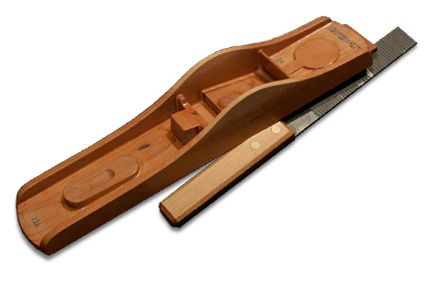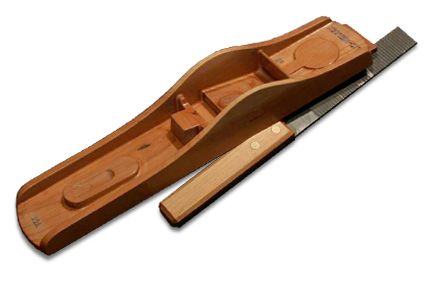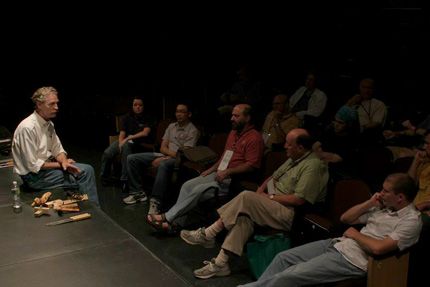How Lie-Nielsen decides which tools to make

Wood patternmaking is almost a lost art, but that is still how Lie-Nielsen's tool makers develop the castings for each new plane.
Lie-Nielsen Toolworks‘ small size is an asset in many ways. While bigger companies must do exhaustive research to figure out what to make and how to do it profitably, it only takes a few requests to get Tom Lie-Nielsen to start making prototypes.
In a fascinating workshop at the recent Furniture Society Conference in Massachusetts, Lie-Nielsen explained how he takes a new tool from concept to market. I though the best part was learning how he chooses what to develop and make next. Turns out, the process is informal. “If we get a couple of requests for a specific tool,” Lie-Nielsen said, “I figure there are a lot more people behind those two.” He went on to explain that as a small company, they can afford to develop and sell a tool that they will only sell a couple hundred of, such as a few of his more esoteric planes that do just one small job very well.
Lie-Nielsen Restraints
One tool, a hand-cut rasp, just takes too much time and expertise for his Maine company to handle. At the Auriou company, in France, it takes an extremely experienced worker up to a full day, working with a tiny punch, to form the teeth on a single rasp. “It takes three years to train the guy,” Lie-Nielsen explained with a wry smile.
But there are reasons he can’t make tools, too. For example, he revealed, he is trying his hardest to make a honing guide, or rather a set of them, because he isn’t really happy with the generic guide that his employees recommend in their sharpening seminars (see our recent article by Lie-Nielsen demonstrator Deneb Puchalski). But he can’t figure out how to make them at a price that people will be willing to pay. The generic honing guides hold plane irons OK, but they don’t hold either large or small chisels well at all. Therefore Lie-Nielsen thinks he needs to offer a set of three in order to do justice to the task, but, he asked us at the seminar, what will people be willing to pay? The consensus was $100 and he wasn’t quite sure if he could make them profitably at that price. But he remains determined to do so and continues to work on prototypes.
Another thing Lie-Nielsen can’t handle is hammer forging, which is the wonderful way old chisels were made. It is a lost art in the U.S. Drop-forging is a modern option but the dies for it cost $20K each. So Lie-Nielsen found a way to machine his socket chisels from carbon steel, and is very happy with the result.
Lie-Nielsen Collaborations
When asked if he only feels comfortable developing tools on his own, he said he loves collaborating, mentioning the inlay tools he created with Steve Latta and the spokeshaves he made according to Brian Bogg’s VERY specific requirements.
He said he did flirt with making infill planes, years ago, and had a devil of a time doing it in production, but the solution came in an unexpected way. When people began asking for a No. 4-1/2 smoother, a wider version of the No. 4, he complied and it became one of his favorites. He said the No. 4 only became the traditional smoother of choice because of ignorance and because it could do a lot of things well. When he added a high-angle frog as an accessory for his No. 4-1/2, he said, he found he had created a plane that rivals the best coffin smoothers when it comes to tough woods. So he didn’t need to make an infill smoother any more.
As for low-angle planes (all the rage these days) vs. standard smoothers, he says the low-angles make a great first plane because one only has to resharpen the bevel to create a new planing angle, but there is still no substitute for a standard plane with a high-angle frog for the toughest woods. As for why block planes were seemeingly the only low-angle planes made in the past, he said that there were low-angle smoothers but they became unpopular because of their poor quality. It takes a flat frog, a thick blade and thick castings to make them work well, and cost-cutting did in the past versions.
Lie-Nielsen Can Make Small Batches
Fine Woodworking associate editor Matt Kenney‘s recent experience with Lie-Nielsen illustrates the flexibility the company has when it comes to making a small run of tools to meet the demands of a unique market:
First, a bit of back story. From time-to-time, I attend Lie-Nielsen hand tool events. It gives me a chance to meet some of our readers, demonstrate how I use hand tools in my work, and, well, just talk about hand tools (something I love to do). I always bring along my own tools, and among the ones I bring are my grooving planes. When I brought them to an event in Massachusetts last fall, Thomas Lie-Nielsen caught sight of them. I explained what they were, how I came up with the design, and he gave them a try. He was impressed. I made the irons for the planes from some molding plane blanks that Lie-Nielsen manufactures and sells on its website. Making them involved grinding down a wider iron, hardening the steel and then tempering it. I don’t mind a little metal work now and then, but not everyone is as adventurous as me.
Now for the point. I told Thomas that we were going to run an article that explains how to make the planes and asked if he would be interested in making and selling the irons needed for them, so that our readers wouldn’t have to do all of the metal work. He immediately said yes. I was a bit surprised, but very happy. We’ve since worked out the details and the irons will be available on the Lie-Nielsen website when the article runs. It’s great that the company is nimble enough to be able to produce a small run of specialty plane iron so that our readers will have less of a hurdle to jump should they decide to make the planes. And it’s great that Thomas is accessible and will listen to ideas.
*NOTE: Matt Kenney received no remuneration for the development or sales of the aformentioned plane irons.
More from FineWoodworking.com:
- Lie-Nielsen: Unplugged
- Martha Stewart Visits Lie-Nielsen
- Who Begat Who? Comparing Lie-Nielsen, WoodRiver and Stanley Planes
- Lie-Nielsen Toolworks and Woodcraft Part Ways
- Shop Talk Live Ep. 70: Lie-Nielsen Live



















Comments
We're all still waiting for the article. Is it still in the "works?"
You did say it was coming at the LN session in NJ.
--
Steve
OOps, Matt said it was coming.
Steve,
I did say it (the article about me grooving planes) was coming, but not until the end of the year (at the soonest). I still cannot say with any certainty when it will be out, but it is coming.
Matt
Hi Matt-
Thanks for the quick response.
I'm looking for the article, video, whatever, anxiously.
Still using my 1/8" router bit until then.
--Steve.
Thanks for the L-N article. We toolmakers can't get enough, or sometimes anything about toolmaking.
Thomas is one of the best and I want to second the fact that it's refreshing to have a business owner that will take a chance and also provide such a great service. A few years ago Thomas made a custom backsaw for me and only charged the price of his production saw. I really appreciate his presence in our craft.
Joe Freeman
hello friends i am a new user and i am from India
i want making guitar so please give me guidance and send me video link about guitar making thanks
Log in or create an account to post a comment.
Sign up Log in